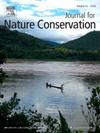Predicted losses over the 21st century in climatically suitable areas of threatened Muriquis (Primates, Brachyteles) in the Brazilian Atlantic Forest hotspot
IF 2.5
3区 环境科学与生态学
Q2 BIODIVERSITY CONSERVATION
引用次数: 0
Abstract
Despite conservation plans had been elaborated for the critically endangered Muriqui species (Brachyteles arachnoides and B. hypoxanthus), they do not take into account the current climate change. In order to provide a dynamic overview of the potential distributional species’ range over successive decades (four future climate change time slices: 2030, 2050, 2070, and 2090), I aimed to answer the following questions: i) Will the climatically suitable areas of the two Muriqui species be lost continuously or concentrated at a given specific time slice over this century? ii) Where, in the geographical space, are concentrated the losses and/or gains of predictive areas? and iii) What are the extent of the distributional range shifts for the species over the current century? Using selected climatic variables, four ecological niche modelling algorithms, and an ensemble approach to generate final binary distribution models, I found that the main climate change effects on the distribution of the two Brachyteles species are related to continuous losses in their climatically suitable areas at magnitudes varying from ∼44 % (B. hypoxanthus) to ∼61 % (B. arachnoides) until the end of this century. These presumed losses will be followed by northeastward range shifts and the main potential distributions of both species are likely to be restricted to the coastal Atlantic Forest, posing specific challenges of local extinction risk for inland populations of both species.
巴西大西洋森林热点地区21世纪气候适宜地区受威胁Muriquis(灵长类,短叶猴)的预测损失
尽管已经为极度濒危的Muriqui物种(Brachyteles arachnoides和B. hypoxanthus)制定了保护计划,但它们没有考虑到当前的气候变化。为了对未来几十年(2030年、2050年、2070年和2090年四个未来气候变化时间片)的潜在分布物种范围提供一个动态的概述,我旨在回答以下问题:I)在本世纪内,两个Muriqui物种的气候适宜区域是持续消失还是集中在给定的特定时间片上?ii)在地理空间上,预测区的损失和/或收益集中在哪里?以及iii)本世纪该物种的分布范围变化的程度如何?通过使用选定的气候变量、四种生态位建模算法和一种集成方法来生成最终的二元分布模型,我发现气候变化对这两种短叶藻分布的主要影响与它们在气候适宜地区的持续损失有关,其损失幅度从~ 44% (B. hypoxanthus)到~ 61% (B. arachnoides)不等,直到本世纪末。在这些假定的损失之后,它们的分布范围将向东北方向移动,这两个物种的主要潜在分布可能仅限于大西洋沿岸森林,这对这两个物种的内陆种群构成了当地灭绝风险的具体挑战。
本文章由计算机程序翻译,如有差异,请以英文原文为准。
求助全文
约1分钟内获得全文
求助全文
来源期刊

Journal for Nature Conservation
环境科学-生态学
CiteScore
3.70
自引率
5.00%
发文量
151
审稿时长
7.9 weeks
期刊介绍:
The Journal for Nature Conservation addresses concepts, methods and techniques for nature conservation. This international and interdisciplinary journal encourages collaboration between scientists and practitioners, including the integration of biodiversity issues with social and economic concepts. Therefore, conceptual, technical and methodological papers, as well as reviews, research papers, and short communications are welcomed from a wide range of disciplines, including theoretical ecology, landscape ecology, restoration ecology, ecological modelling, and others, provided that there is a clear connection and immediate relevance to nature conservation.
Manuscripts without any immediate conservation context, such as inventories, distribution modelling, genetic studies, animal behaviour, plant physiology, will not be considered for this journal; though such data may be useful for conservationists and managers in the future, this is outside of the current scope of the journal.
 求助内容:
求助内容: 应助结果提醒方式:
应助结果提醒方式:


